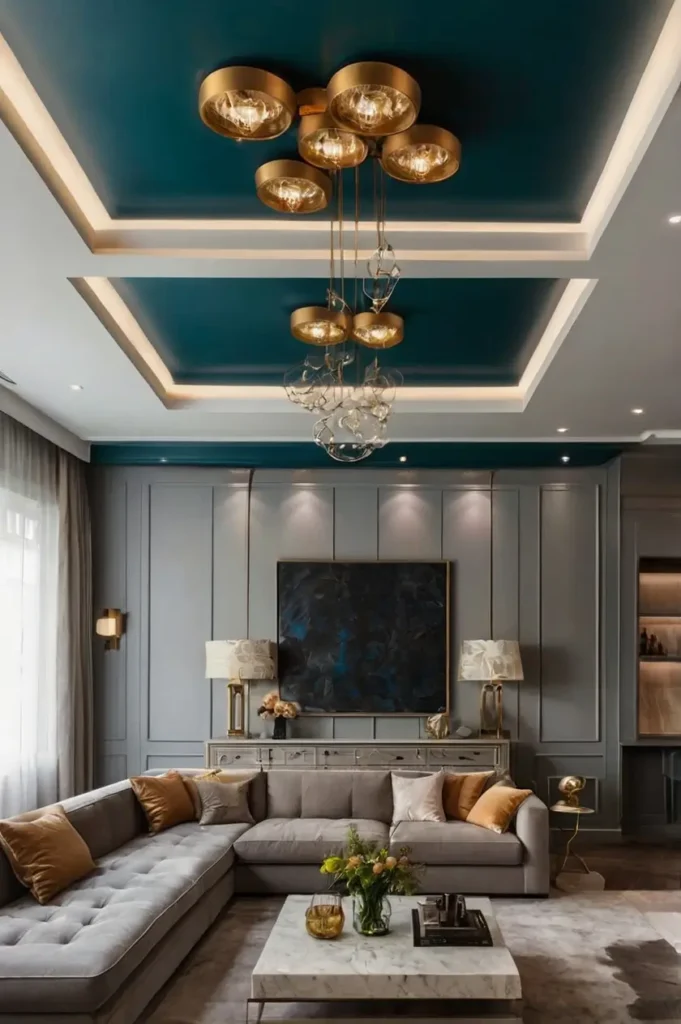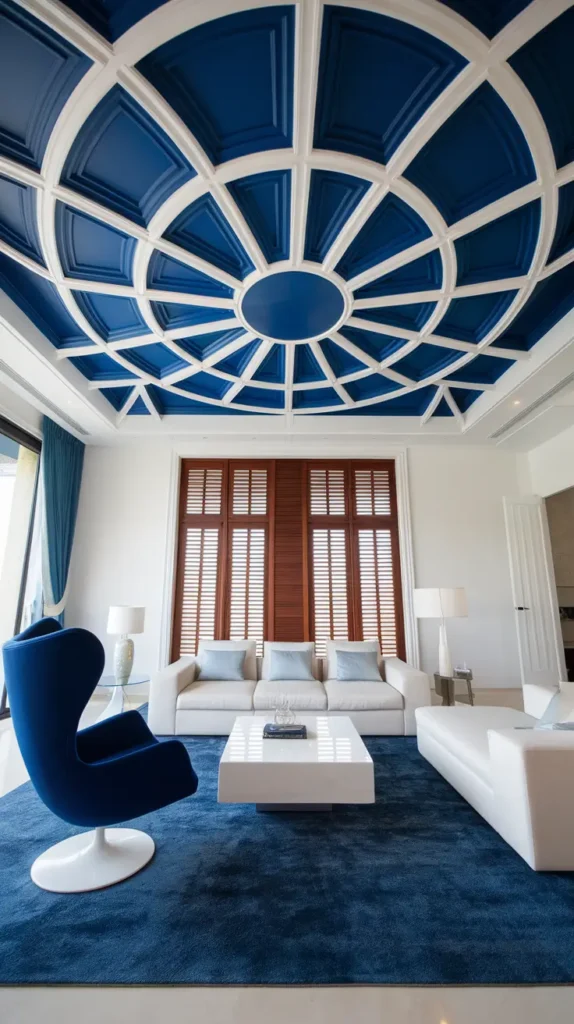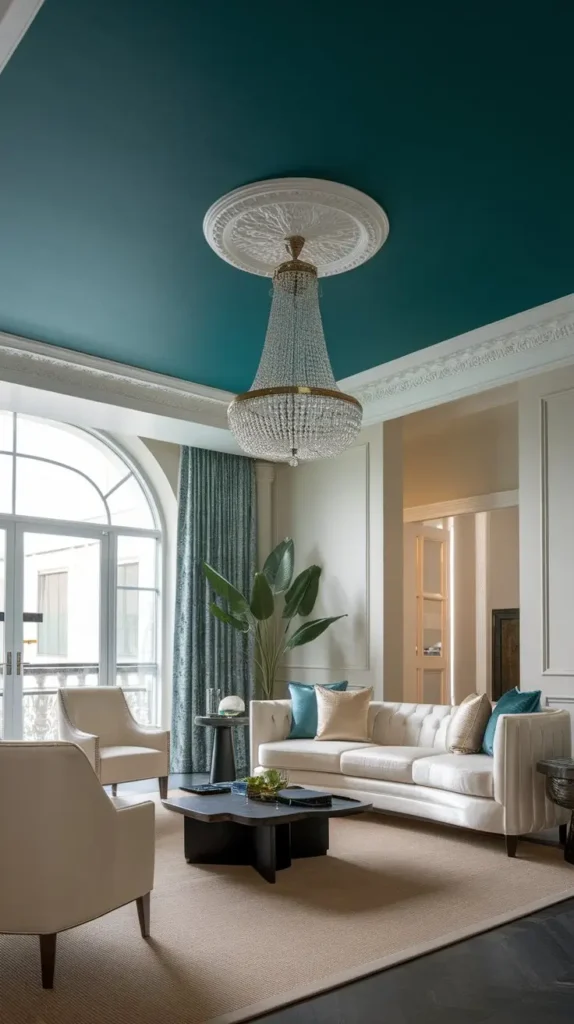Plaster Ceiling Design Ideas: Transform Your Space with Timeless Elegance
Plaster ceilings have long been celebrated for their aesthetic charm, timeless beauty, and ability to elevate any room. Whether you’re looking to add an element of opulence or create a minimalist vibe, plaster ceiling designs offer endless possibilities.
In this article, we’ll explore a variety of plaster ceiling design ideas that can suit different spaces and styles, from ornate, classical ceilings to sleek, modern finishes.
Table of Contents
1. Elegant and Ornate Plaster Ceiling Ideas

Ornate plaster ceilings have a rich history and are synonymous with classical, luxurious interiors. They add sophistication and character to any room, often transforming an otherwise simple space into something remarkable. These designs are perfect for large, grand rooms or spaces that aim for a timeless, elegant feel.
Key Features:
- Intricate Molding & Cornices: Detailed plaster cornices and crown molding are commonly used in ornate ceiling designs. These can range from delicate floral patterns to more intricate, baroque-inspired scrollwork. Crown molding, when paired with walls painted in soft tones, creates a beautiful, continuous flow from the walls to the ceiling.
- Medallions: A central plaster medallion serves as a stunning focal point, often placed around a chandelier or pendant light fixture. These medallions are available in various shapes and designs, including floral, geometric, and Victorian styles. They’re perfect for creating an impressive visual in dining rooms, living rooms, or entryways.
- Baroque & Rococo Styles: Baroque-style plaster ceilings are highly ornate with intricate detailing, such as floral motifs, swirls, and leaf designs. Rococo, a more delicate variation of baroque, uses lighter and more flowing curves. This style works best in homes with a traditional or vintage look, particularly in spaces like dining rooms or formal living rooms.
Design Suggestions:
- Grand Entryway or Dining Room: An intricate plaster medallion in the center of the ceiling, surrounded by floral plaster moldings and detailed cornices, creates a sense of opulence in your entryway or dining area. A chandelier in the center adds further drama.
- Formal Living Room: Use sweeping, symmetrical designs, with detailed ceiling moldings and finely worked plaster cornices that extend across the room. A large, central medallion with gilded accents can be the focal point, particularly with soft lighting around it.
2. Modern Plaster Ceiling Ideas

Modern plaster ceiling designs focus on simplicity, clean lines, and minimalistic elegance. The idea is to create an unassuming yet chic ceiling that seamlessly integrates with contemporary interiors. Smooth, sleek finishes and subtle designs make modern plaster ceilings incredibly versatile for various home decor styles, including contemporary, Scandinavian, and industrial.
Key Features:
- Sleek, Smooth Finish: For a modern aesthetic, a flat, smooth plaster ceiling with no added texture or ornate details is ideal. The simplicity of the design draws attention to other aspects of the room, such as large windows, minimalist furniture, and open space.
- Geometric Patterns: Modern plaster ceilings can feature geometric shapes or angular patterns. These include straight lines, squares, and rectangles that give the ceiling a structured, organized feel. This style can be used in various rooms, from living spaces to kitchens, and pairs well with contemporary design elements like industrial light fixtures or floating furniture.
- Exposed Beams: In some modern interiors, plaster can be used around exposed wooden or metal beams to create an industrial, yet polished look. This style adds an architectural edge to the room without overwhelming the space.
Design Suggestions:
- Living Room with Clean Lines: Opt for a smooth, plain plaster ceiling with hidden LED strip lighting that casts a soft glow along the edges of the ceiling. This type of ceiling works perfectly with minimalist furniture and neutral tones.
- Geometric Patterns for a Loft: In an open-concept loft or apartment, use plaster to create geometric patterns—simple squares or rectangles—along the ceiling. You can add subtle recessed lighting into the geometric shapes for a clean, modern finish.
3. Coffered Plaster Ceiling Ideas

Coffered ceilings are a classic design element that incorporates recessed panels, which can be square, rectangular, or even octagonal. These ceilings bring depth and dimension to any room. Coffered plaster ceilings add structure and elegance, and they work beautifully in spaces where you want to add architectural interest, such as dining rooms, libraries, or large living areas.
Key Features:
- Grid Pattern: The defining feature of a coffered ceiling is its grid pattern, which creates a series of square or rectangular recesses in the ceiling. These can be either shallow or deep, depending on the level of drama you want to achieve.
- Classical & Modern Variations: Traditional coffered ceilings often feature ornate plaster detailing along the edges of the recesses, whereas modern coffered ceilings tend to focus on a simpler design with clean lines and minimal decoration.
- Lighting Integration: Coffered ceilings are often paired with lighting, such as recessed or pendant lights, to highlight the depth of the panels. In modern designs, LEDs can be integrated into the coffered grid to cast light up or down.
Design Suggestions:
- Formal Dining Room: A deep coffered ceiling with finely detailed plaster moldings around each panel will create a grand and luxurious atmosphere in your dining room. Pair it with a crystal chandelier for a truly opulent look.
- Home Office or Library: A coffered plaster ceiling with a shallow design and simple, clean lines is perfect for a more sophisticated, less ornate look in a home office or library. Darker wood paneling or leather furniture pairs well with this style.
4. Textured Plaster Ceiling Designs

Textured plaster ceilings bring warmth and character to a room by adding a tactile element to the design. The texture of plaster can range from subtle and smooth to rough and rustic. Textured plaster ceilings are ideal for creating a cozy, inviting space or to complement more rustic, Mediterranean, or boho styles.
Key Features:
- Stucco Finish: A classic option for textured plaster ceilings, a stucco finish gives the ceiling a rough, tactile feel, reminiscent of Mediterranean or Spanish-style architecture. It can range from a smooth stucco texture to a more pronounced, rough finish.
- Swirl Patterns: A plaster swirl pattern can add a unique, artistic touch to the ceiling, making it feel more dynamic and less flat. Swirls can be subtle or dramatic, depending on the effect you wish to achieve.
- Hand-Troweled Plaster: This technique uses a trowel to apply the plaster, creating a distinctive, handcrafted texture that gives the ceiling a more organic, earthy appearance. This is perfect for rustic or industrial-style rooms.
Design Suggestions:
- Mediterranean or Spanish Living Room: A textured stucco plaster ceiling adds rustic charm to a Mediterranean-style living room. Pair it with terracotta tile floors, arched doorways, and wrought-iron chandeliers for an authentic look.
- Boho Bedroom: A hand-troweled plaster ceiling with subtle swirls can be an excellent addition to a bohemian-style bedroom. Pair it with natural materials like wood furniture, woven rugs, and earthy colors.
5. Plaster Ceiling Ideas for Small Rooms

When working with small spaces, plaster ceilings can help to open up the room and make it feel larger. By using design tricks like light colors and subtle textures, you can make the most of a small room while still introducing the beauty of plaster ceilings.
Key Features:
- Light Tones: Light-colored plaster, especially whites, off-whites, and pale neutrals, can help reflect light, making the room feel more spacious. These colors help elevate the ceiling visually, drawing the eye upward and creating a sense of height.
- Smooth, Flat Finish: A smooth, flat plaster ceiling without added textures or patterns helps create an airy, uncluttered atmosphere. The simplicity of this design helps avoid overwhelming a small room and gives the space a serene, open feel.
- Vertical Elements: In a small room, consider using vertical patterns or grooves in the plaster to visually elongate the walls. This technique can give the room the illusion of more height and make it feel less confined.
Design Suggestions:
- Small Bedroom: For a small bedroom, a smooth, light-colored plaster ceiling with subtle recessed lighting around the edges will create a sense of spaciousness while maintaining a cozy, peaceful atmosphere.
- Compact Living Room: Use a simple, flat plaster ceiling in light tones, paired with light-colored walls and minimalistic furniture. Adding a single central light fixture or a small, stylish chandelier can add elegance without overwhelming the space.
6. Plaster Ceiling Ideas for Small Rooms

Small rooms can feel more spacious and open with the right plaster ceiling design. By choosing the right colors, textures, and patterns, you can enhance the feeling of height and openness, making the room feel larger and more inviting.
Key Features:
- Light Colors: The most effective way to make a small room feel larger is to use light-colored plaster. Whites, off-whites, and soft neutrals will reflect light, which makes the space feel airy and expansive. Lighter tones also make the ceiling seem higher, creating a sense of openness.
- Minimal Texture: A smooth, flat plaster ceiling is ideal for small rooms because it creates a clean, seamless look. Avoid heavy textures or intricate patterns, which can make the space feel closed off or too busy.
- Use of Vertical Lines: If you’re working with a small space with a low ceiling, consider incorporating vertical lines or grooves in the plaster to draw the eye upward. This will create the illusion of height and make the room feel taller than it actually is.
Design Suggestions:
- Small Bedroom: For a compact bedroom, a smooth, white plaster ceiling with recessed lighting along the edges will help the space feel more expansive. Light colors and a lack of patterns will create a calming, open atmosphere.
- Compact Living Room: Opt for a simple, clean plaster ceiling in a light tone. Use vertical grooves or slight indentations in the plaster to enhance the sense of height. Adding a single, central light fixture, like a pendant light, can provide just enough warmth without overpowering the small space.
7. Plaster Ceiling Ideas with Lighting Integration

Incorporating lighting into your plaster ceiling design is a great way to create an atmosphere of warmth and ambiance. Plaster ceilings allow for seamless integration of lighting fixtures, making them an essential part of modern interior designs.
Key Features:
- Recessed Lighting: Recessed lighting, or “downlights,” can be seamlessly integrated into the plaster ceiling. These are ideal for creating a clean, modern look and are perfect for rooms where you don’t want the light fixtures to draw too much attention.
- Cove Lighting: Another way to integrate lighting into plaster ceilings is by creating a cove or ledge at the perimeter of the ceiling. Hidden LED strips can be installed along the edges, casting a soft glow that accentuates the ceiling’s architectural detail and adds a sophisticated touch to the room.
- Pendant or Chandelier Fixtures: Use plaster medallions or medallion-style moldings around light fixtures like chandeliers or pendant lights. This combination adds elegance while allowing the light fixture to remain a focal point of the room. Plaster medallions can be simple or ornate, depending on your style.
Design Suggestions:
- Living Room or Dining Room: In the living or dining room, opt for a central plaster medallion with a hanging chandelier. Integrating hidden LED cove lighting along the edges of the ceiling will give the room a soft, ambient light that doesn’t overpower the decor.
- Kitchen: In a modern kitchen, use recessed lighting within a smooth, minimalist plaster ceiling to keep the space well-lit without adding visual clutter. This setup works well for kitchens with high ceilings or open shelving.
8. Creative Plaster Ceiling Ideas for Bedrooms

Bedrooms are spaces where comfort, relaxation, and a sense of serenity are key. Plaster ceilings can be designed to enhance the mood of the room, whether you’re looking for a soft, calming atmosphere or a more dynamic, creative statement.
Key Features:
- Soft Curves and Subtle Patterns: For a restful bedroom, opt for plaster ceilings with soft curves, gentle floral patterns, or even light textures. These designs help create a cozy and serene environment. The smoothness of the plaster adds a sense of calm without overwhelming the space.
- Accent Colors: While many bedrooms feature neutral-colored plaster ceilings, adding a subtle accent color can add a personal touch. Light blues, soft grays, or warm beiges can create a tranquil and relaxing environment.
- Starry or Dreamy Ceilings: For a whimsical touch, consider adding a starry or sky-inspired plaster ceiling. Using glow-in-the-dark paint or delicate patterns, you can create a night-sky feel in the bedroom, ideal for a more playful or dreamy atmosphere.
Design Suggestions:
- Serene Master Bedroom: A smooth plaster ceiling in soft tones, paired with subtle recessed lighting, can create a peaceful and restful environment. Adding a gentle swirl pattern or light, geometric designs will add depth without overwhelming the room.
- Children’s Bedroom: For a children’s bedroom, a plaster ceiling with a dreamy, starry pattern can add an element of fun and wonder. Glow-in-the-dark plaster accents or a soft blue palette will enhance the whimsical feeling.
9. Plaster Ceiling Ideas for Living Rooms and Dining Areas

Living and dining rooms are often the focal points of the home, and the ceiling design can play a significant role in setting the mood for these spaces. Plaster ceilings in these areas can be grand, elegant, or modern, depending on the overall theme of your home.
Key Features:
- Coffered Ceilings: Coffered plaster ceilings, with their recessed panels and grid pattern, add depth and architectural interest to large living rooms or dining areas. These ceilings can be either ornate or minimalist, depending on the style you choose.
- Statement Medallions: A large plaster medallion can serve as the centerpiece for a dining or living room ceiling, particularly if you have a chandelier or other prominent lighting fixture. These medallions can be simple or intricately designed, depending on the vibe you want to create.
- Exposed Beams: For a more rustic or industrial look, consider combining plaster ceilings with exposed beams. The contrast between the smooth plaster and rough wood or metal beams creates visual interest and adds texture to the room.
Design Suggestions:
- Formal Dining Room: Use a detailed coffered plaster ceiling with recessed panels and molding for a traditional or formal look. A central chandelier with a plaster medallion will complement the ornate ceiling design. Opt for deep, rich colors and plush furniture to complete the luxurious atmosphere.
- Contemporary Living Room: For a modern living room, combine a smooth, flat plaster ceiling with recessed lighting along the edges. This design is subtle yet sophisticated, and works well with contemporary furniture and clean lines.
10. Plaster Ceiling Ideas for Kitchens and Bathrooms

Kitchens and bathrooms are functional spaces where the ceiling can play a key role in enhancing both the style and practicality of the room. While these areas need to be durable, they can still benefit from the aesthetic appeal of plaster ceilings.
Key Features:
- Moisture-Resistant Plaster: In bathrooms, it’s essential to use moisture-resistant plaster that won’t degrade from high humidity or steam. Textured plaster can help add character while maintaining the functionality of the space.
- Simple, Smooth Designs: For both kitchens and bathrooms, consider smooth plaster ceilings without too many intricate designs. This keeps the space feeling clean and fresh, which is especially important in areas where cleanliness is a priority.
- Recessed Lighting: Plaster ceilings in kitchens and bathrooms can be designed with recessed lighting, creating soft, even light without the need for visible light fixtures. This is perfect for areas where overhead space is limited or where a minimalist look is preferred.
Design Suggestions:
- Modern Kitchen: A smooth, clean plaster ceiling with integrated recessed lighting will give the kitchen a fresh, modern look. You can pair this with industrial-style lighting fixtures or pendant lights over the island for added visual appeal.
- Spa-Inspired Bathroom: A moisture-resistant plaster ceiling with a subtle texture can add a spa-like feel to your bathroom. Combine this with hidden LED strip lighting along the edges of the ceiling to create a soft glow that enhances the serene atmosphere.
Conclusion: Choosing the Best Plaster Ceiling Design for Your Home
Plaster ceilings bring elegance, character, and a timeless appeal to any room. Whether you’re opting for a luxurious, ornate ceiling or a sleek, minimalist design, the possibilities are endless.
The key is to choose a plaster ceiling design that complements the overall style of your home and enhances the mood of each room. Whether you’re decorating a grand living room or a cozy bedroom, plaster ceilings can truly transform your space, adding both beauty and functionality.
Read More:
Originally posted 2024-12-11 16:29:15.

